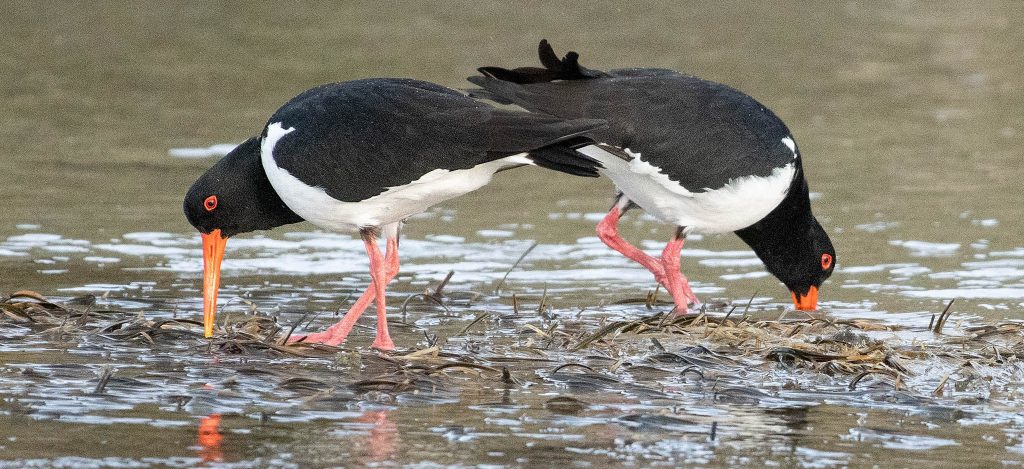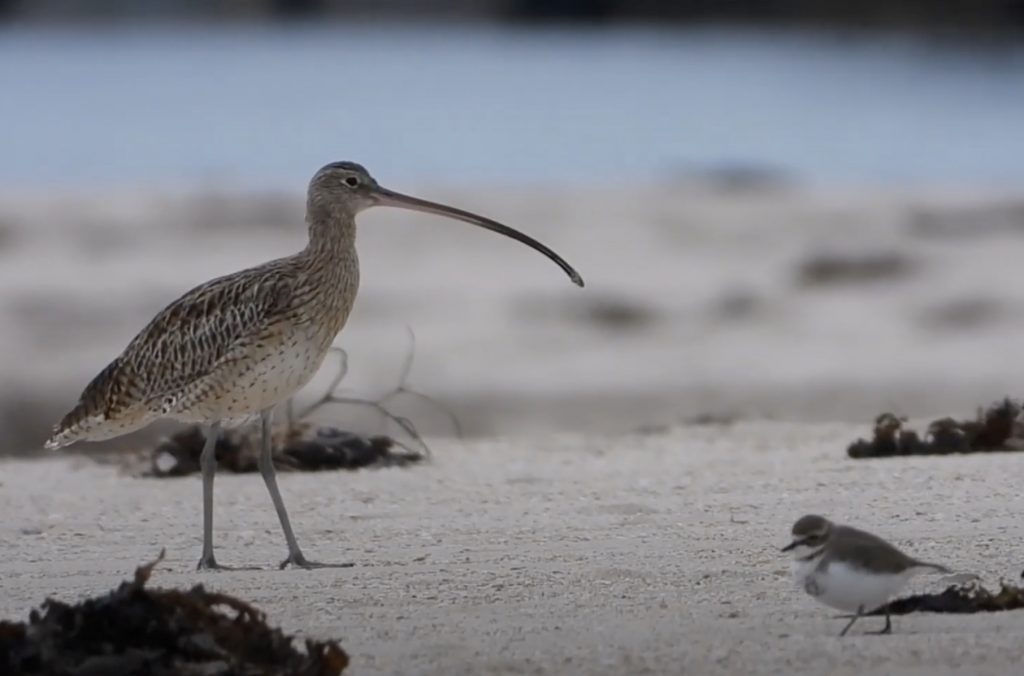
Photo credit Julie Keating.
______________________
Many people do not realise how extraordinary our local Sutherland Shire migratory shorebirds are, or know about the huge distances they travel.
The eastern curlew and bar-tailed godwit that we see in the Shire come from as far away as Alaska and Siberia, their breeding grounds.
Eastern curlew start to arrive in the Shire each year from late July after flying around 11,000 km non-stop, spending more than a week in the air crossing the Pacific Ocean from China. From September the bar-tailed godwits begin arriving, in epic non-stop flights from Alaska. Pumping their wings all the while, what they do surpasses the most punishing bootcamp ordeal, both species can lose 70% of their body weight during these flights.
In 2020 an eastern curlew fitted with a tracker was found to have flown ten days and nights non-stop.
Other migratory birds arriving in the Shire during Autumn travel to and from New Zealand. Double-banded plovers weigh about as much as a pack and a half of snack box sultanas, yet are able to make this flight across the Tasman Sea.
Towra and Port Hacking are recognised nationally as important migratory shorebird habitat. Some of the shorebirds migrating from the Arctic, such as Red Knot, rest temporarily in both areas, before moving further south to Victoria and Tasmania. For others, the intertidal flats, sandbanks, beaches, and sand spits of Towra Point, the Georges and Woronora Rivers, and Port Hacking, are their summer home. Young shorebirds generally do not undertake their long migration until they are at least two years old. Eastern curlew may be three or four years old before they set off. A small number of bar-tailed godwit and eastern curlew usually ‘overwinter’ in Botany Bay and Port Hacking. Other shorebirds live in the Shire permanently, such as Pied and Sooty Oystercatchers.

______________________
Sadly, the number of all our shorebirds has plummeted in recent years, across all species. The reason for the crash in numbers is believed to be habitat loss, the destruction of ecosystems these birds rely on to survive.
Shorebirds have a lovely call, the curlews in particular. To lose this population will diminish the soundscape of the Shire, as well as our estuaries and catchment areas.
Eastern curlews are now formally classified as critically endangered: their population has declined by more than 80% in the past 30 years. Bar-tailed godwits are classified as vulnerable.
Pied oystercatchers are endangered, and there are believed to be less than 200 nesting pairs across all of New South Wales.
There are a number of dedicated volunteers across the Sutherland Shire who are doing what they can to help all our local shorebirds survive. It is by no means certain this will be enough to prevent those populations which are hovering on the brink of extinction from tipping over that edge.
Volunteer local shorebird expert, Julie Keating, recently gave a webinar presentation for Greater Sydney Local Land Services on the Port Hacking shorebirds, and the issues they face.
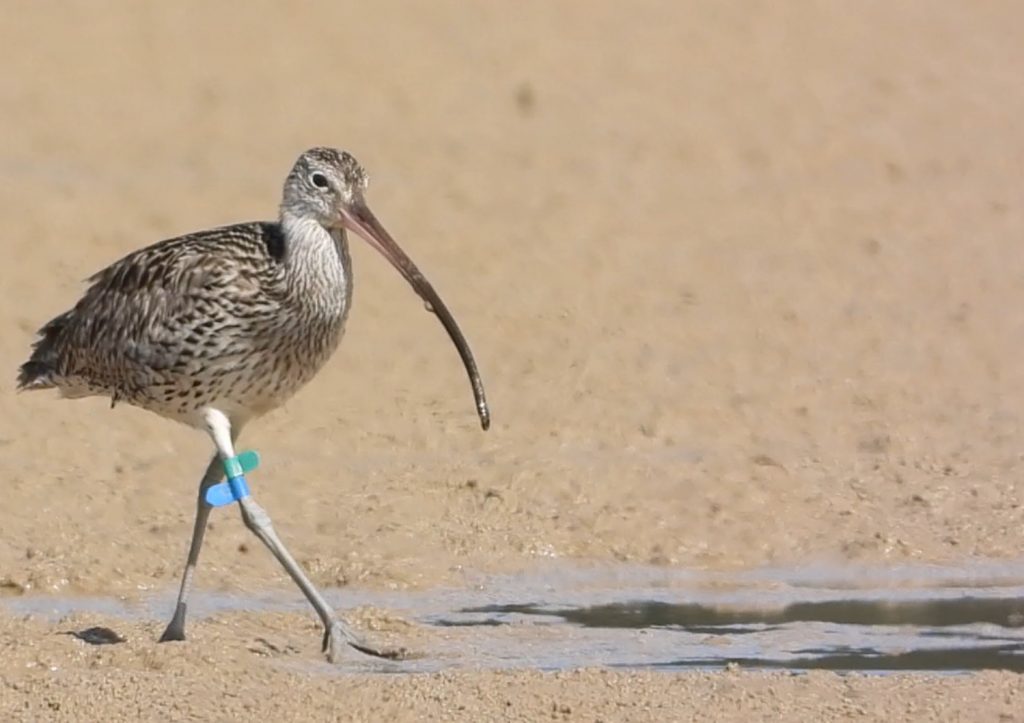
______________________
The trip the migratory shorebirds make is incredible, and it is hard enough for them, even without habitat destruction.
With the strong winds this year, ‘one unlucky godwit, who was being tracked, was forced to take a huge u-turn over the Pacific ocean and finished up back at his Alaskan take-off point after 57 hours of constant flight.’
Organisations such as the Georges Riverkeeper, Sutherland Shire Council, Greater Sydney Local Land Services, and the National Parks and Wildlife Service all take various actions to improve shorebird habitat; this includes weed control on beaches, fox control, control of eroding sand, and removing vegetation to expose mudflats.
More work is needed to protect the areas shorebirds rely on to survive.
Birdlife Australia is another organisation that provides supports through research, advocacy, and education. Working in conjunction with the Australasian Wader Studies Group, their volunteers take part in initiatives such as the Australian Shorebird Monitoring program, a formal system of keeping track of shorebird numbers.
There is also an international network, the East Asian Australasian Flyway Partnership, which involves collaboration between different national governments, intergovernmental agencies and NGOs.
Even with the help of all these local, national, and international groups, volunteers still need the support and help of Sutherland Shire residents.
The more people who learn about our shorebirds and what is needed to protect them, the more chance we’ll have for the future.
In Nelson, New Zealand, the cathedral rings its bells to celebrate the arrival of their bar-tailed godwits, and cathedral staff read out a prayer of thanks.
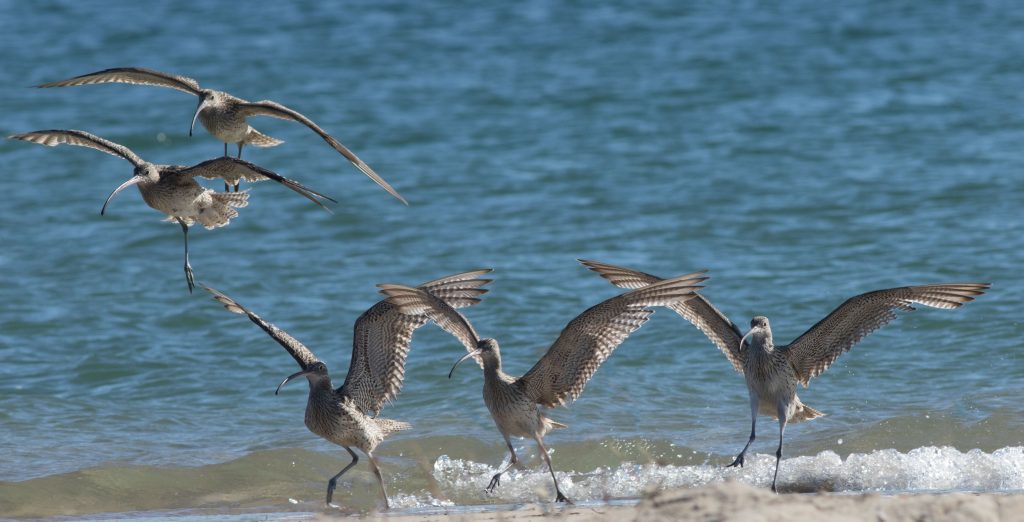
______________________
Speaking to others about why shorebirds are so important will make a difference. We want to be able to keep these birds in the Shire, not just now, but in years to come.
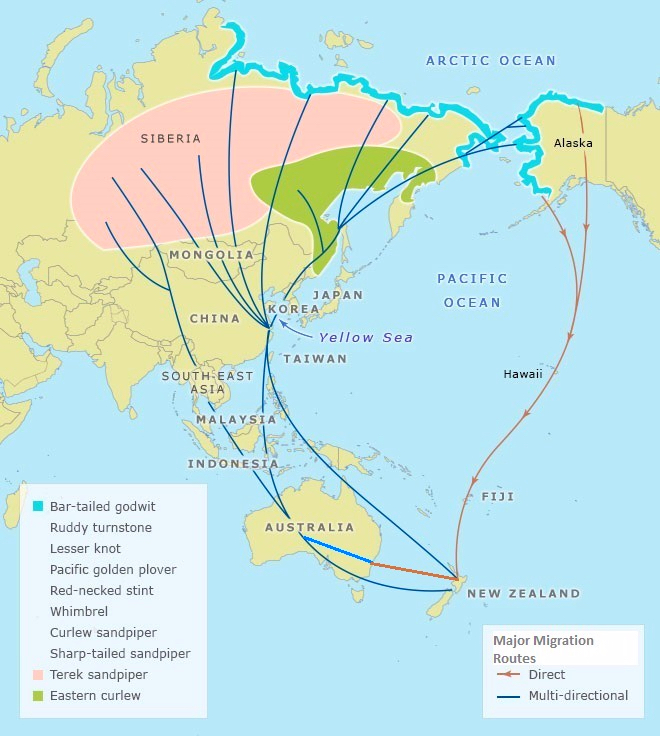
It’s extraordinary how migratory shorebirds can instinctively time their arrival in the Arctic for when after the snow melts, and the warm weather produces a plentiful supply of insects. If they are too early and there isn’t enough food, they might die. Once there, they also only have a few short weeks to find a mate, lay their eggs, and protect the eggs and young from predators, before beginning their journey back to Australia.
What is also astonishing is that the shorebirds leave the northern hemisphere without their newly-fledged chicks. The young birds have to wait several more weeks before they are strong enough to make the journey themselves. How they are able to navigate the route is unknown: it may all be by instinct. Meanwhile the enormous distance, bad weather and strong winds can make the journey incredibly hazardous. Even their bodies change through the flight, with unnecessary digestive organs shutting down to conserve energy.
When they arrive back in the Shire all the shorebirds are in desperate need of rest and food. They need to regain all the body fat they lost during their long flight.
Spit Island at Towra Point, and Deeban Spit in Port Hacking are important habitat: seagrass, mudflats, coastal saltmarsh, mangroves, freshwater wetlands, and sandbars all provide food and shelter. Food shorebirds eat include small fish, crustaceans, worms, and mollusks.
Debbie Andrew has been studying shorebirds for over twenty years, and she also spoke at the recent webinar we hosted with Greater Sydney Land Services. The below slides from her presentation relate to the feeding strategies of different species. For shorebirds to be able to gain weight after their long flight is critical.
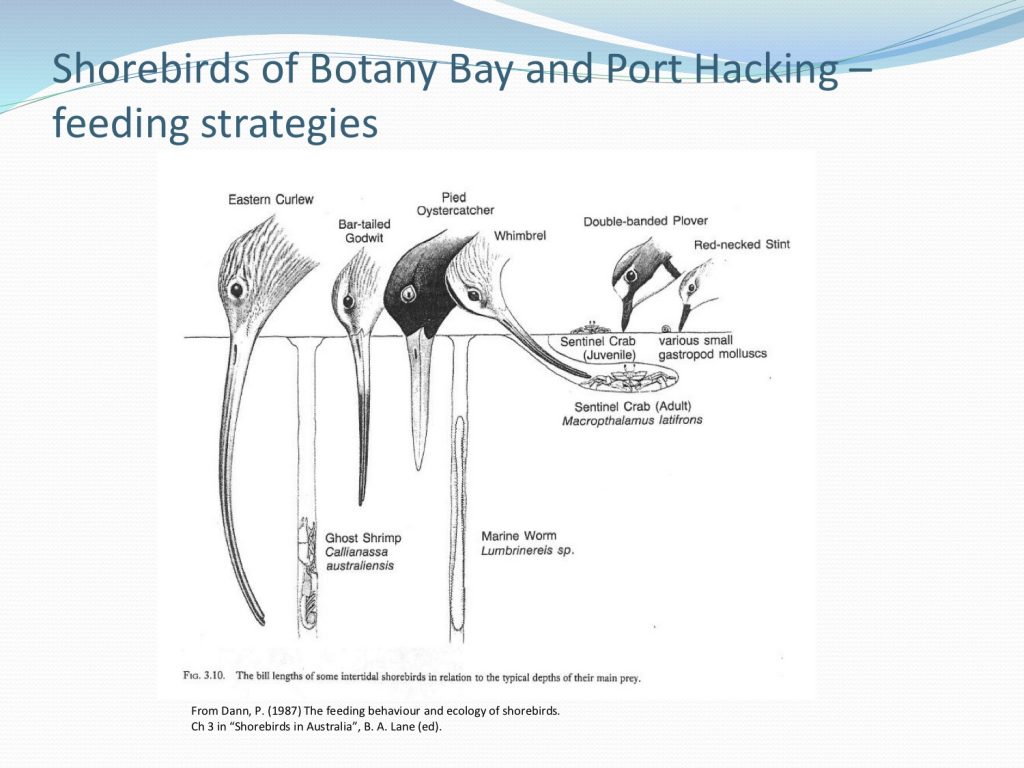

Allowing shorebirds to feed undisturbed when the tide is low is very important. After feeding, they also need a safe, quiet place to rest, as close to their feeding areas as possible (this is called a roosting site).
Towra Point Nature Reserve is officially classified as a Ramsar wetland of International Importance, and is a wonderful refuge. But other areas in the Shire have also been set aside to protect shorebirds and other wildlife. Certain prohibitions apply to these areas: and dogs are not allowed to enter, whether they are wearing leashes or not. Dogs are viewed by shorebirds as predators, that can run at speed.

______________________
Unfortunately some dog owners do not understand that even the scent of dogs can alarm shorebirds and can cause them to take flight. Many dog owners also do not recognise that what seems like harmless chasing can mean the difference between life and death for these fragile populations.
If our local, non migratory shorebirds are disturbed when they are nesting this can also be fatal: when birds see a dog they sometimes leave their nests in an attempt to keep the location of the nest hidden. In summer, this can be long enough for the eggs to bake on the hot sand. Eggs can fail to hatch, chicks can starve, or be eaten by predators while their parents are away.
For beach nesting birds such as endangered pied oystercatchers and masked lapwings, eggs and chicks are also vulnerable to being stepped on. Oystercatcher chicks wander along the beach in search of food as they are growing. It can take seven long weeks for these little chicks to fledge, and learn to fly so they can escape out of harm’s way.
Sutherland Shire Council has also asked people to help protect our shorebirds, so they can rest and feed undisturbed. And Council has provided information for dog owners about off leash areas where they can freely roam, without putting any shorebirds or their chicks in danger.

➤ To find out more about our Sutherland Shire Shorebirds and how you can help please contact office@ssec.org.au
➤ Birdlife Australia also provides some fantastic support for volunteers who are keen to do what they can to look after our shorebirds
https://www.birdlife.org.au/support-us/volunteer/
➤ Finally, and not least, thanks to Greater Sydney Local Land Services (GSLLS) for their support and sponsorship of the Southern Sydney Shorebirds webinar as part of their Towra Point RAMSAR project. GSLLS is working with local partners including National Parks & Wildlife, Sutherland Shire Council, and the Georges Riverkeeper on a range of actions to improve local habitat for shorebirds such as Eastern Curlews and Bar tailed Godwits.
______________________
Further reading and resources
14 July, 2023, “Sydney dog owners’ beach act threatens critically endangered species“, yahoo!news
16 June, 2023, “Call for Botany Bay safety zone for shorebirds“, The Leader
1 March, 2023, “BirdLife Australia refers Port Hacking dredging to federal government and calls for ‘immediate cessation’“, The Leader
19 July, 2022, “Shorebird experts disagree on impact of removing old barges at Taren Point“, The Leader
24 May, 2022, “Council to lift dog waking ban on Woolooware Bay shared path section once mitigation measures are implemented“, The Leader
10 October 2021, “Migrating birds make massive journey to shire“, The Leader
23 September 2021, “Cathedral bells ring out as New Zealand welcomes godwits after longest migration”, The Guardian
6 September 2021, Life is a Flyway podcast with Professor Richard Fuller
D.J. Reid, January 2021, “A review of the ‘natural’ ecological features of waterways in the Botany Bay catchment, in southern Sydney, Australia”, in Regional Studies in Marine Science, Volume 41
10 June 2020, “Wings of wonder: shorebirds that fly the equivalent of to the moon and back”, ABC Radio
6 June 2020, “Eastern Curlew’s 10-day flight to China stuns bird enthusiasts calling for greater habitat protections”, ABC News
25 November 2019, “New interactive map shows where you can and can’t walk your dog in the Shire”, The Leader
19 March, 2019, “Endangered seabirds nest successfully on Deeban Spit with help of volunteers”, The Leader
4 September, 2018, “St George Christian School wades into protection for shorebirds” The Leader
15 June, 2018, “Shorebirds face extinction activists warn” The Leader
2 January, 2018, “Surveillance of endangered shorebird nesting areas at Towra Point ramped up for holiday period” The Leader
14 March, 2017, “Court challenge over state government blocking plans for up to 2000 condominiums around Boat Harbour on Kurnell peninsula” The Leader
7 June, 2016, “Oh My Godwit – The Longest Bird Migration in the World” Journeyman TV
5 September, 2014, “Development near Boat Harbour shacks may threaten birds and marine life” The Leader
October 2013, The Vertebrate Fauna of Towra Point Nature Reserve, Office of Environment & Heritage NSW National Parks & Wildlife Service
Photos of shorebirds at Deeban Spit, from the Shire Shorebirds Diary
Birdlife Australia Shorebird ID Booklet
Birdlife Australia Shorebird Activity Booklet (ages 5-7)
Kate Gorringe-Smith’s The Overwintering Project: migratory shorebird advocacy for artists
The ANSTO Shorebird poster drawing competition (for Year 3 to 6 primary students)
Gary Dunnett’s Flicker – with beautiful photos of shorebirds at Botany Bay
“Fly me to the moon! Migratory shorebirds are flying for their lives”, Natura Pacifica
East Asian Australasian Flyway Coastal high-tide shorebird habitat management guidelines


